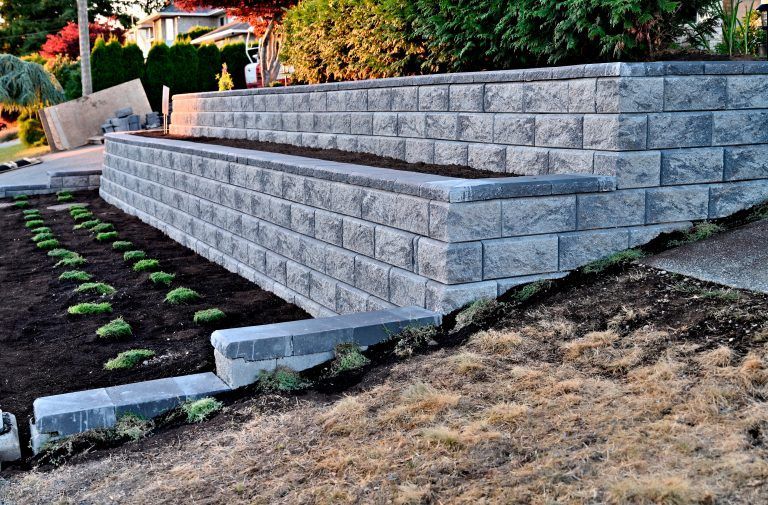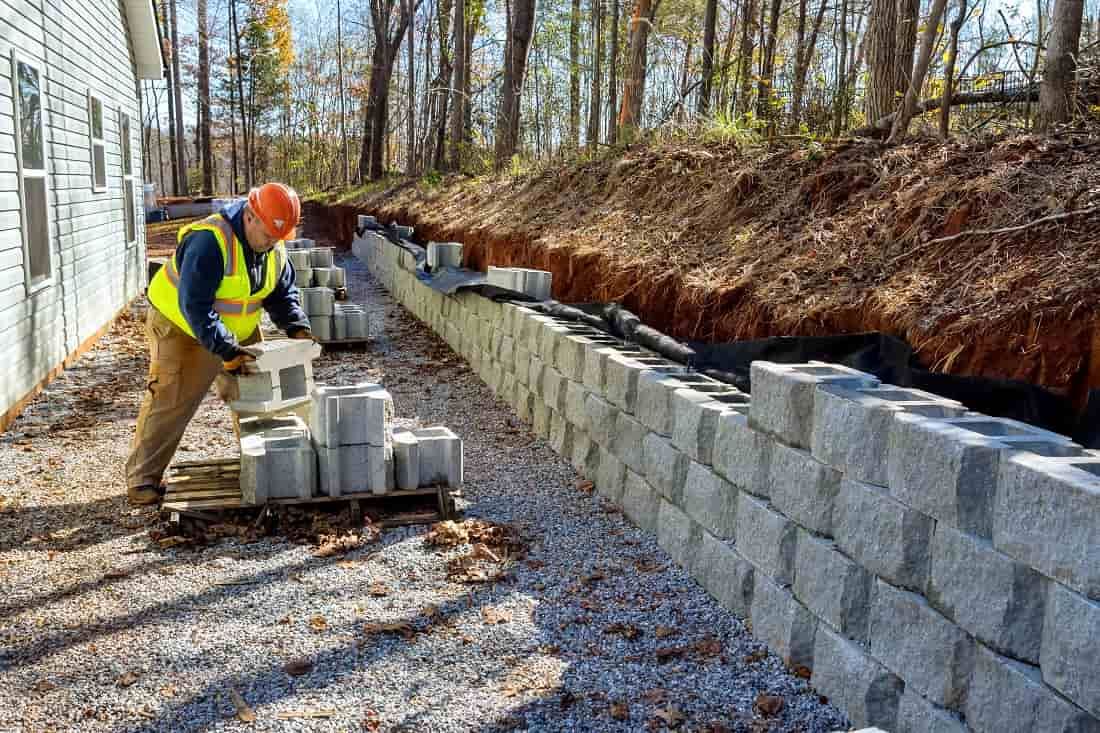
Concrete Coquitlam
(778) 909-6949
Concrete Retaining Walls In Coquitlam, British Columbia, Canada
Concrete retaining walls provide a functional and attractive solution for managing slopes, preventing erosion, and defining outdoor spaces. At Concrete Coquitlam, we specialize in constructing high-quality concrete retaining walls that are built to withstand the elements and offer long-lasting durability. Our expertly crafted walls are created to resist cracking, weathering, and shifting, ensuring stability and aesthetic appeal for years to come. We use the highest grade cinderblocks Whether you’re looking to create terraced gardens, enhance your landscape design, or solve drainage issues, trust us to deliver retaining walls that blend strength with style. Contact us today to start your project!
A Comprehensive Guide To Types of Concrete Retaining Walls

Ready to transform your outdoor space with quality cinder block built retaining walls that are built to last? Concrete retaining walls offer the positive combination of strength, low maintenance, and aesthetic appeal, making them a perfect choice for enhancing your home's landscape. Whether you're managing slopes, preventing erosion, or creating defined garden areas, well-designed concrete retaining walls can significantly improve your property's functionality and curbside aesthetic. With a variety of design options available, from sleek, modern finishes to textured patterns, selecting the right concrete retaining wall in Coquitlam, British Columbia, Canada, has never been easier. In this guide, we’ll explore the different types of concrete retaining walls to help you create a landscape that is both practical and beautiful.
Gravity Retaining Walls
Description: These walls rely on their own weight to resist the pressure from behind. They are typically thicker at the base and taper off towards the top.
Applications: Suitable for low to moderate heights and less complex site conditions.
Benefits: Simple construction, cost-effective, and stable due to the wall’s mass.
Cantilever Retaining Walls
Description: Cantilever walls use a reinforced concrete base and a stem that cantilevers from the base to support the soil behind the wall. They are often used for taller walls.
Applications: Ideal for moderate to high retaining walls.
Benefits: Efficient use of materials, can support taller heights, and often more aesthetically pleasing.
Counterfort Retaining Walls
Description: These walls are similar to cantilever walls but include additional concrete "counterforts" or buttresses that help reinforce the wall.
Applications: Suitable for high walls where additional support is needed.
Benefits: Provides greater stability and reduces the thickness of the wall, making it more cost-effective for taller structures.
Segmental Retaining Walls
Description: Consist of interlocking concrete blocks or units that do not require mortar. These walls rely on gravity and friction between the blocks to hold back soil.
Applications: Commonly used for garden walls, landscaping, and terracing.
Benefits: Easy to install, flexible design, and can accommodate various shapes and curves.
Modular Block Retaining Walls
Description: Constructed from pre-cast concrete blocks that are assembled on site. They often include a system of pins or keys to hold the blocks together.
Applications: Suitable for both residential and commercial projects, especially where aesthetics and design flexibility are important.
Benefits: Versatile, easy to install, and available in various colors and textures.
Tieback Walls
Description: Use tensioned steel rods or cables anchored into the ground behind the wall to provide additional support and stability.
Applications: Effective for high walls or in situations where space behind the wall is limited.
Benefits: Provides extra support for high or unstable walls, and minimizes the required wall thickness.
Green or Living Retaining Walls
Description: Incorporate vegetation into the wall design, either through soil-filled panels or integrated planting areas.
Applications: Ideal for environmentally friendly designs and aesthetic enhancement.
Benefits: Provides erosion control, improves visual appeal, and enhances ecological benefits.
A concrete retaining wall provides a strong and durable solution for managing soil erosion, enhancing landscape design, and adding structural support to your outdoor space. With various design options available, from decorative finishes to functional retaining systems, you can create a structure that is both practical and visually appealing. At Concrete Coquitlam, we specialize in constructing high-quality retaining walls tailored to your specific needs. Ready to elevate your landscape? Contact us today to begin your project and build the perfect concrete retaining wall for your property.
How to Properly Maintain Your Concrete Retaining Walls?

Concrete retaining walls offer the ideal blend of strength, functionality, and aesthetic appeal for managing soil and creating level landscapes. With various types available, including gravity, cantilever, and modular block walls, you can choose the perfect solution to support and enhance your outdoor space. At Concrete Coquitlam, we specialize in designing and installing durable, high-quality cinder block retaining walls that address your specific needs and preferences. Ready to elevate your landscape? Contact us today to begin your project and create a retaining wall that combines both form and function for your property.
- Regular Cleaning: Keep your retaining walls clean by sweeping it regularly to remove debris and dirt. For a deeper clean, use a pressure washer or a mild detergent with a broom or scrub brush. Avoid using harsh chemicals that can damage the concrete.
- Seal the Concrete: Apply a high-quality concrete sealer every 1-3 years to protect the surface from stains, moisture, and UV damage. Sealing also helps to prevent cracks and maintain the retaining walls appearance.
- Address Stains Promptly: Clean up spills and stains as soon as possible to prevent them from setting. For oil or grease stains, use a degreasing cleaner or a mixture of baking soda and water. For rust stains, try a rust remover designed for concrete.
- Repair Cracks and Chips: Inspect your retaining walls regularly for cracks or chips and address them promptly to prevent further damage. Use a concrete crack filler or patching compound for minor repairs. For larger cracks or structural issues, consult a professional.
- Control Weeds and Moss: Remove weeds and moss that grow between cracks or along the edges. Use a weed killer or a mixture of vinegar and water to treat these areas. Regularly inspect and maintain the edges of your walkway to prevent weed growth.
- Prevent Water Damage: Ensure proper drainage around your retaining walls to prevent water pooling or runoff that can lead to erosion or damage. Keep gutters and downspouts clear to direct water away from the walkway.
- Avoid Heavy Loads: Avoid parking or placing heavy objects on your retaining walls that could cause cracking or surface damage. Be cautious with snowplows and heavy machinery to prevent scarring or gouging the surface.
- Protect from De-icing Chemicals: In winter, avoid using harsh de-icing chemicals that can damage concrete. Opt for sand or a salt-free de-icer to minimize potential harm.
- Regular Inspections: Conduct routine inspections of your retaining walls to catch any signs of damage early. Look for signs of cracking, discoloration, or other issues that might require attention.
- Professional Maintenance: For significant repairs or maintenance needs, such as resurfacing or extensive crack repairs, consider consulting a professional to ensure the work is done correctly and effectively.
- Winterization: Winter can be harsh with cold temperatures, ice, and snow. Proper winterizing is crucial to keeping your concrete retaining walls in good condition during the winter months. Be sure to remove any leaves or other debris from your pool deck before the first snow. Avoid using harsh chemicals, such as rock salt, to melt ice, as these can damage the concrete surface. Instead, use a rubber-tipped shovel to remove snow and ice, or a mild de-icing agent designed for use on concrete.
Proper maintenance of your concrete retaining walls is essential for ensuring its longevity and keeping it looking great. By following key practices such as regular cleaning, sealing, timely repairs, and managing water drainage, you can maintain your pool deck’s durability and aesthetic appeal. Routine inspections are also crucial for identifying and addressing minor issues before they escalate. With consistent care, your concrete retaining walls will remain a beautiful and functional part of your outdoor space for years to come.